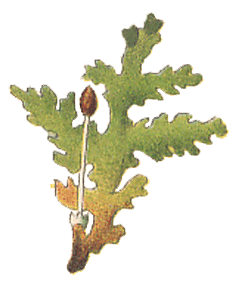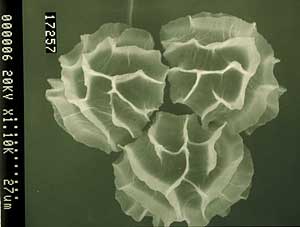
Life cycle
Sporophyte development
A sporophyte develops from an egg, held within a flask-like archegonium, that has been fertilized and there's more about that process in the SEXUAL REPRODUCTION page.
The fertilized egg grows by the formation of additional cells. In the great majority of species the embryonic sporophyte elongates and one part becomes a foot that penetrates the gametophyte and anchors the embryonic sporophyte to the gametophyte. The opposite end will develop into the spore-bearing capsule (and also the supporting stalk, or seta, in species in which the mature capsule is stalked). The embryonic sporophyte is often protected by a calyptra, a covering that develops from the wall of the archegonium. The calyptra is therefore a very close covering over the embryonic sporophyte. This photo ![]() shows an intact, reddish calyptra over an embryonic sporophyte of the moss Dawsonia longiseta. In addition to the calyptra there is often some additional protective covering though in a number of genera the tissue of the calyptra fuses with other tissue to form a composite protective covering.
shows an intact, reddish calyptra over an embryonic sporophyte of the moss Dawsonia longiseta. In addition to the calyptra there is often some additional protective covering though in a number of genera the tissue of the calyptra fuses with other tissue to form a composite protective covering.
The thallose liverwort genus Riccia provides examples of bryophytes where the sporophyte does not develop a foot. A Riccia sporophyte ![]() consists of just a spherical spore capsule that develops within the thallose gametophyte.
consists of just a spherical spore capsule that develops within the thallose gametophyte.
The details about sporophyte development are in the following pages, one for each bryophyte group:
Spore development
Within a spore capsule sporogenous cells give rise to the spores but not all sporogenous cells need give rise to spores. The sporogenous cells that will produce spores first differentiate into spore mother cells or sporocytes. Bryophyte spores typically develop as tetrads, which is to say in groups of four. Each such group of four develops from one spore mother cell and the four spores are closely packed in a tetrahedral formation. This photo shows three of the four spores in a tetrad, the fourth being out of sight behind the central area in the visible trio of spores.
In some liverworts not all spore mother cells produce spores. Instead a number of spore mother cells abort to become sterile nutritive or nurse cells which help nourish the developing spores. This happens, for example, in the thallose liverwort genera Riccia and Sphaerocarpos.
The ELATERS or pseudo-elaters found in liverwort or hornwort capsules are also derived from sporogenous cells. At the same time as various sporogenous cells are transforming into spore mother cells other sporogenous cells are transforming into elater mother cells which give rise to the elaters or pseudo-elaters.
![An Australian Government Initiative [logo]](/images/austgovt_brown_90px.gif)


